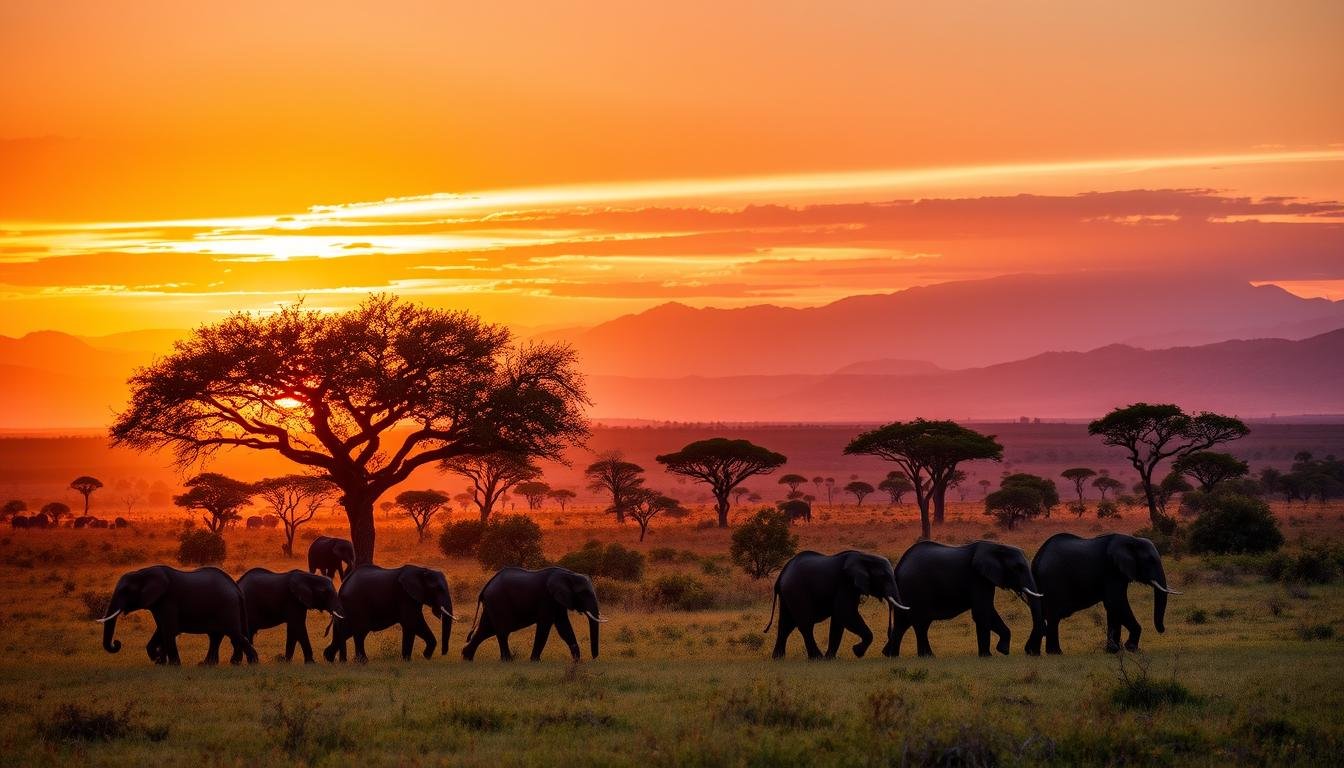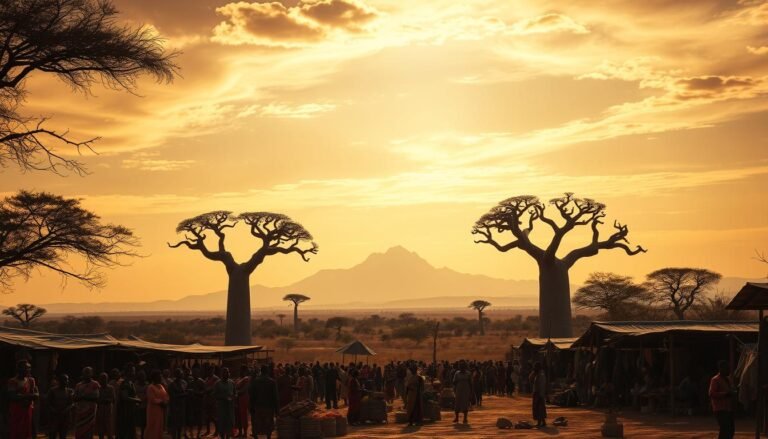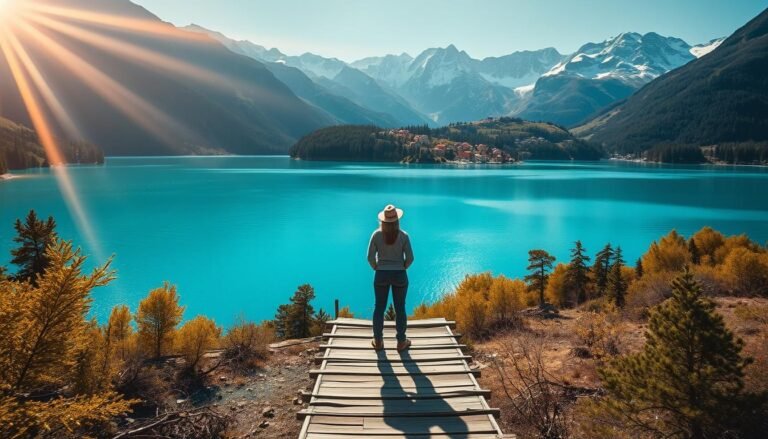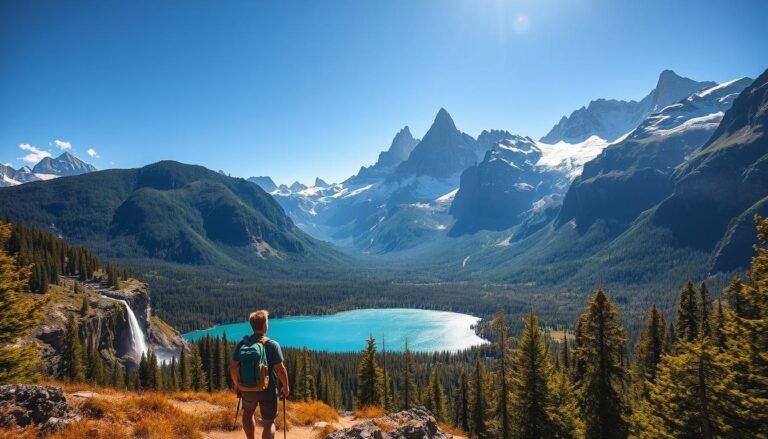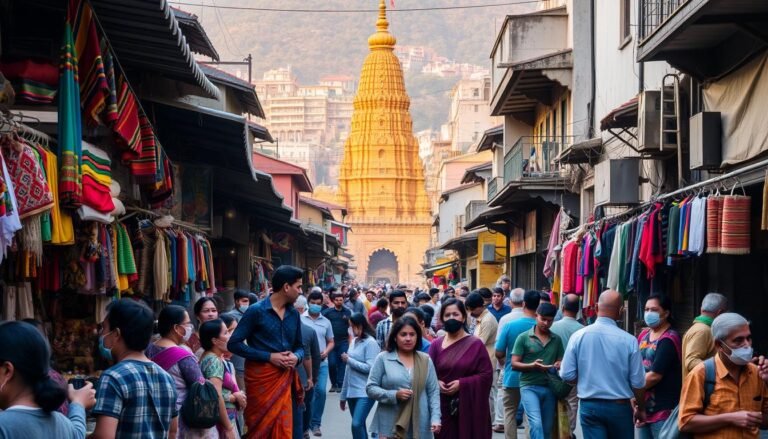Best Time to Go to Africa: A Complete Seasonal Travel Guide
Africa, a continent of vast and varied landscapes, offers a unique travel experience that changes with the seasons. The climate and weather conditions play a significant role in determining the quality of your trip, from wildlife viewing to accessibility and comfort. best time to go to africa
Understanding the seasonal variations across Africa is crucial for planning an unforgettable adventure. Whether you’re drawn to the savannas, deserts, or tropical coasts, the timing of your visit can dramatically impact your experience.
As you prepare for your journey, this guide will help you navigate the complexities of Africa’s climate, ensuring that you’re in the right place at the right time for an unforgettable travel experience.
Key Takeaways
- Africa’s climate varies significantly across regions, affecting travel experiences.
- Seasonal changes impact wildlife viewing opportunities and accessibility.
- Understanding local weather conditions is key to a successful trip.
- Regional breakdowns and practical travel advice will be provided.
- Africa offers incredible travel opportunities year-round with proper planning.
Understanding Africa’s Climate Patterns
Africa’s diverse climate patterns play a crucial role in determining the best time to visit the continent. The vast and varied landscapes, from deserts to rainforests, experience different weather conditions throughout the year.
General Climate Overview of the African Continent
The African continent encompasses a wide range of climates, from the hot deserts of the north to the tropical rainforests of the central regions. The climate varies significantly from one region to another, with factors such as altitude, latitude, and proximity to the ocean influencing local weather conditions. Understanding these variations is key to planning a successful trip.
Dry vs. Wet Seasons: What to Expect
The dry and wet seasons in Africa have distinct characteristics that impact travel experiences. During the dry season, typically from May to October in Southern Africa, game viewing is at its best due to the concentration of wildlife around water sources. In contrast, the wet season, from December to March, brings lush landscapes and the birthing of many animals, although it can also lead to challenging travel conditions due to intense rainfall.
Travelers can expect different conditions during these seasons. For instance, the dry months offer better visibility for wildlife viewing, while the wet season provides a unique opportunity to see newborn animals and enjoy the continent’s lush vegetation. Understanding these seasonal changes is crucial for making informed decisions about the best time to visit Africa.
Best Time to Visit Southern Africa
The best time to visit Southern Africa depends on the specific countries and experiences you’re looking for. This region encompasses a diverse range of climates and landscapes, from the subtropical coastlines of South Africa and Mozambique to the arid deserts of Namibia and Botswana.

South Africa: Cape Town, Kruger, and Beyond
South Africa is a year-round destination, but the best time to visit depends on your interests. For pleasant temperatures and fewer crowds, consider visiting during the shoulder season (April-May or September-October). Cape Town is lovely during these periods, with mild weather ideal for exploring the city and its surroundings.
Botswana, Namibia, and Zimbabwe
For safari enthusiasts, the dry season (May to October) is the best time to visit Botswana, Namibia, and Zimbabwe. During this period, wildlife congregates around water sources, making it easier to spot animals. The temperatures are comfortable, especially in the mornings and evenings.
Victoria Falls: Timing Your Visit
Victoria Falls is a spectacular destination that can be visited year-round, but the experience varies with the seasons. The dry season (May to October) offers better views of the falls as the water level is lower, while the wet season (November to April) brings a lush, green landscape and a more dramatic flow.
Mozambique and Coastal Regions
Mozambique’s coastline is best visited during the dry season, from May to November, when temperatures are pleasant and rainfall is minimal. This period is ideal for beach holidays, diving, and snorkeling. The coastal regions north of Durban to Pemba enjoy warm seas and sunshine throughout the year.
Best Time to Go to Africa’s Eastern Regions
The best time to visit East Africa depends on your preferences, whether you’re looking for a safari experience, a beach holiday, or trekking opportunities. East Africa’s diverse regions, including Kenya, Tanzania, Uganda, Rwanda, and Zanzibar, offer a range of activities and experiences that are best enjoyed during specific times of the year.
Kenya and Tanzania Safari Seasons
For those interested in safaris, Kenya and Tanzania offer world-class wildlife experiences. The best time for safaris in these countries is during the dry season, from June to October, when animals congregate around water sources, making them easier to spot. The Great Migration, a spectacle that involves millions of wildebeest, zebras, and gazelles, is a highlight of the safari calendar, with different months offering viewing opportunities in different locations.
Uganda and Rwanda: Gorilla Trekking Calendar
Uganda and Rwanda are renowned for gorilla trekking, an exhilarating experience that allows visitors to observe these majestic creatures in their natural habitat. The best time for gorilla trekking is during the dry seasons, from June to September and December to February, when the trails are less muddy and more accessible. Permits are limited, so planning ahead is essential.
Zanzibar and East African Beaches
For a tropical beach holiday, Zanzibar and other East African coastal destinations are ideal. The best time to visit these islands is between June and March, when the weather is dry and pleasant. The heavy rainy season from April to May can impact beach activities, although it’s a period for lower rates. Kenya’s coast is hot and humid year-round, with rain possible at any time, making it advisable to avoid the coast from March to May.
In conclusion, East Africa’s varied regions offer a range of experiences that cater to different preferences and interests. By understanding the best times to visit these regions, travelers can plan their trips to maximize their enjoyment and create lasting memories.
Safari Experiences Through the Seasons
Africa’s safari experiences are shaped by the continent’s diverse seasons, offering unique opportunities for wildlife enthusiasts. The varying conditions across the year significantly impact the quality and characteristics of safaris, making some times more suitable for specific experiences than others.
Dry Season Safari Advantages
The dry season, spanning from May to October, offers several advantages for safari-goers. During this period, the dry conditions make it easier to spot wildlife as they congregate around water sources. The dry season is ideal for game viewing as the vegetation is sparse, and animals are more visible.
The dry season is also characterized by comfortable temperatures, making it easier for tourists to navigate the savannas and forests. Many safari operators consider this period as the best time for safaris due to the favorable conditions.
| Characteristics | Dry Season (May-Oct) | Green Season (Nov-Apr) |
|---|---|---|
| Weather | Cool to warm, dry | Hot, humid with rains |
| Game Viewing | Easy, animals congregate around water | Challenging, but newborn animals offer unique opportunities |
| Birdwatching | Good, but some migratory birds are absent | Exceptional, with many migratory species present |
Green Season Safari Benefits
The green season, which runs from November to April, brings its own set of advantages. The landscape is lush and green, providing a picturesque backdrop for safaris. The rainy season also brings an influx of migratory birds, making it an excellent time for birdwatching.
During this period, many herbivores give birth, offering a unique wildlife experience as predators take advantage of the newborns. The green season is also characterized by fewer tourists, making for a more exclusive and peaceful safari experience. Additionally, the rains bring dramatic skies and photogenic landscapes, ideal for photography.
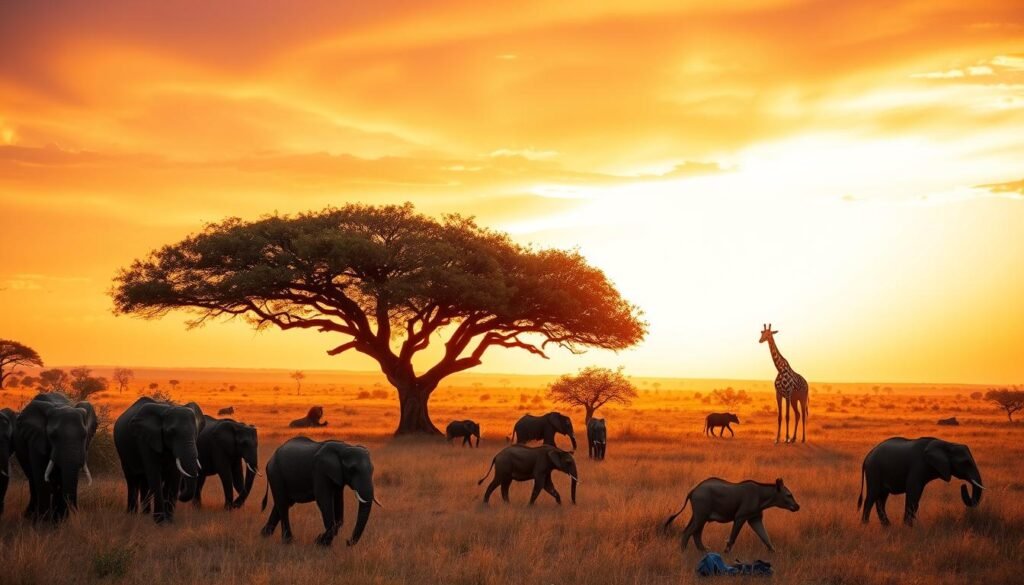
While the green season may present some challenges, such as muddy roads and occasional downpours, many safari operators continue to offer guided tours during this time. With proper planning and flexibility, visitors can enjoy a rewarding safari experience during the green season.
Tracking the Great Migration
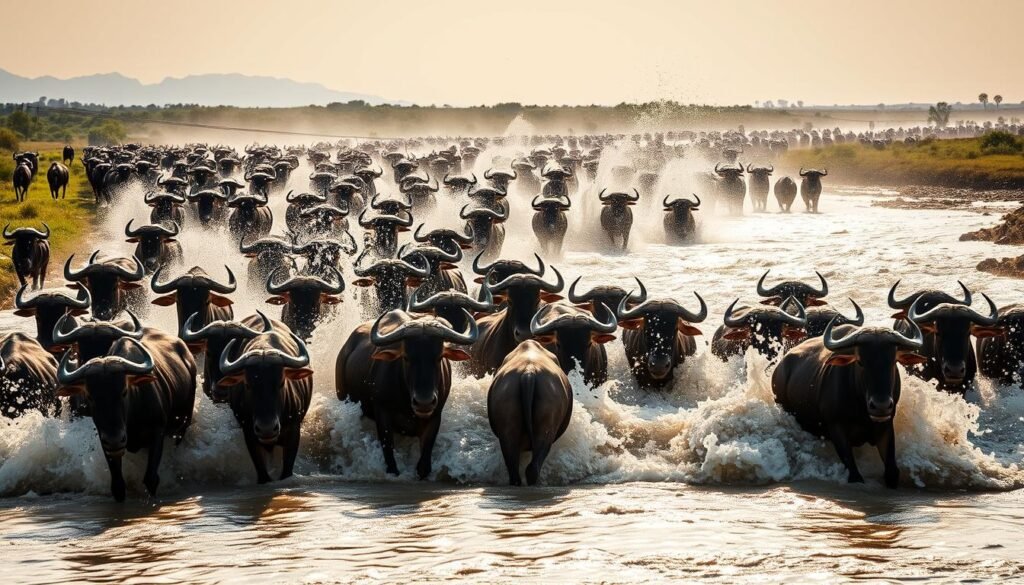
The Great Migration, one of the world’s most spectacular wildlife events, is a must-see for any nature enthusiast. This annual phenomenon involves millions of wildebeest, zebras, and gazelles migrating across the Serengeti and Masai Mara in search of greener pastures.
Serengeti Migration Calendar (January-June)
The Serengeti hosts the Great Migration from January to June, with the calving season typically occurring between January and March. During this time, the southern Serengeti is bustling with newborn wildebeest, making it a prime location for predators.
As the months progress, the herds begin to move northwards, reaching the central Serengeti by May and June, where they graze on the lush grasses.
Masai Mara Migration Calendar (July-December)
From July onwards, the herds move further north into the Masai Mara, a process that peaks with the dramatic Mara River crossings in August and September. Thousands of wildebeest brave the crocodile-infested waters, making for a thrilling spectacle.
During September and October, the herds disperse throughout the Masai Mara, grazing on the nutritious grasses before beginning their southward journey back to the Serengeti.
The return journey, often less documented, is equally fascinating as the herds follow the short rains back toward the southern Serengeti for the calving season, typically from October to December.
Understanding the migration patterns and choosing the right viewing locations can significantly enhance the experience. The Masai Mara offers various viewing options, including the main reserve and private conservancies, each with its own advantages.
Best Times for Unique Wildlife Experiences
From whale watching to bird watching, and zebra migrations, Africa offers a variety of unique wildlife experiences. The continent’s diverse regions provide numerous opportunities for nature lovers and wildlife enthusiasts to witness extraordinary events throughout the year.
Whale Watching in South Africa (July-November)
South Africa’s coastline is renowned for its excellent whale watching opportunities, particularly between July and November. During this period, southern right whales migrate to the coastal waters of South Africa, providing spectacular viewing experiences. Popular spots include Hermanus, Gansbaai, and Plettenberg Bay, where visitors can witness these majestic creatures up close.

Bird Watching Seasons Across Africa
Africa is a paradise for birdwatchers, with various regions offering peak viewing times. The dry season, typically from May to October, is ideal for spotting a wide range of bird species as they congregate around water sources. Countries like Zambia, Zimbabwe, and Botswana are particularly popular during this time. In contrast, the wet season brings an influx of migratory birds, adding to the diversity of species that can be observed.
Zebra Migration in Botswana (November-February)
Botswana’s Makgadikgadi Pans host a lesser-known but spectacular zebra migration between November and February. Approximately 25,000 zebras migrate between the Okavango Delta and the Makgadikgadi Pans, triggered by seasonal rains that transform the salt pans into lush grasslands. This event attracts not only zebras but also wildebeest, antelope, and their predators, creating a thrilling wildlife spectacle.
| Event | Location | Best Time |
|---|---|---|
| Whale Watching | South Africa | July-November |
| Bird Watching | Various African countries | Dry season (May-October) |
| Zebra Migration | Botswana’s Makgadikgadi Pans | November-February |
Month-by-Month Guide to African Travel
Africa’s climate varies significantly from one region to another, making it vital to choose the right time for your visit. Understanding the seasonal patterns across the continent can help you plan a more enjoyable and fulfilling trip.
January to March: Summer in Southern Africa
During these months, Southern Africa experiences its summer season, characterized by warm weather and long days perfect for safari adventures. January and February are ideal for witnessing the Great Migration in the Serengeti. The warm weather makes it an excellent time for outdoor activities.
April to June: Transition Seasons
As the summer months come to an end, April to June marks a transition period across many African regions. The weather begins to cool down, making it a comfortable time to explore. It’s also a great period for safari experiences as the vegetation is still lush, and wildlife is more active.
July to September: Peak Safari Season
This period is considered the peak season for safari enthusiasts. The dry conditions make it easier to spot wildlife, and the clear skies offer breathtaking views. July to September is an excellent time to visit popular destinations like the Maasai Mara and Kruger National Park.
October to December: Early Rains and Holidays
The months from October to December signal the onset of the rainy season in many parts of Africa. While this might deter some travelers, it’s actually a great time to enjoy lower prices and fewer tourists. The early rains bring fresh greenery, attracting herbivores and making it a good time for game viewing. The weather is generally mild, with the exception of occasional rain showers.
In conclusion, Africa offers diverse experiences throughout the year, and understanding the seasonal patterns can help you make the most of your trip. Whether you’re looking for a safari adventure or a relaxing beach vacation, there’s a perfect time to visit Africa.
Practical Considerations for Timing Your African Trip
To ensure a memorable and enjoyable African experience, it’s crucial to consider several key factors when deciding on the best time to travel. Understanding these practical considerations can help you make informed decisions about your trip.
Pricing and Crowds: Peak vs. Off-Peak Travel
Traveling during peak season (typically June to October) comes with higher prices and larger crowds, but it often offers the best weather and optimal wildlife viewing opportunities. In contrast, off-peak travel can be more budget-friendly and less crowded, but may involve dealing with extreme weather conditions or some tourist facilities being closed. It’s essential to weigh these factors based on your priorities.
Weather Comfort and Clothing
The weather in Africa varies significantly across regions and seasons. For instance, during mid-winter, nights can be quite cold, while daytime temperatures are generally mild. Packing layers is advisable to ensure comfort throughout the day. Additionally, considering the climate of your destination and the time of year you’re traveling can help you prepare appropriate clothing.
Health Considerations: Malaria Risk
Malaria risk varies seasonally across different African regions, typically increasing during and after rainy seasons due to higher mosquito populations. The dry winter months (May to October) are generally considered the lowest risk period for malaria in most safari destinations. Travelers with health concerns should consider this when planning their trip. It’s also worth noting that highland areas above 1,800 meters have minimal malaria risk regardless of the season.
Conclusion: Planning Your Perfect African Adventure
The best time to visit Africa is a personal choice, dependent on what you want to see and experience. Africa is a vast and varied continent, offering endless opportunities for unforgettable travel experiences throughout the year.
Whether you’re drawn to the dry season safaris, the lush landscapes of the green season, or specific wildlife events, understanding the seasonal patterns is key to planning your trip. Working with experienced safari planners, like those at AfricanMecca Safaris, can help you guide through the complex seasonal variations across the continent.
Flexibility in your travel plans can also lead to unexpected wildlife encounters. It’s essential to stay informed about weather conditions and regional events that might impact your journey. By choosing the right time and region for your priorities, you can have a truly exceptional African adventure. With careful planning and the right guide, your visit to Africa will be an unforgettable experience, creating lasting memories of the continent’s incredible landscapes, diverse wildlife, and rich cultures.
AfricanMecca Safaris is here to help you plan your dream trip, offering expert travel tours tailored to your preferences.

